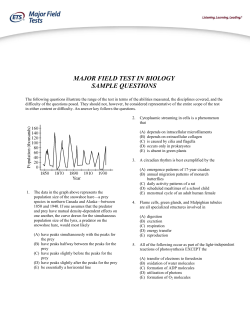
UV, Vis, Mass, PES, IR
Spectroscopy UV, Vis, Mass, PES, IR Visible Light Spectroscopy from AP Chemistry Crash Course, 2nd ed, by Adrian Dingle, 2014 • The technique is generally only useful for colored solutions. • A colorimeter is used (or a Spec-20), and the wavelength of light chosen for the experiment should be complementary to the wavelength of the light reflected by the solution (complementary to the color of the solution). This allows for maximum absorbance (an important aspect of collecting reliable data over a range of concentrations). • Linear plots of absorbance vs concentration are found. • The equation used is A=abc (A is absorbance, a is an absorptive constant, b is path length through the solution, c is concentration) • Beer-Lambert law is used to assess the concentration of a solution by relating the absorbance of the solution to the concentration of the solution Mass Spectroscopy • Often used as evidence for isotopes • Plot of charge/mass ratio on x axis and relative abundance on y axis • The charges of most species at most peaks is +1 The mass spectrometer: A sample of atoms is vaporized and then bombarded with electrons to knock electrons free creating positive ions. The positive ions are accelerated into a beam using an electric field. The positive ions are deflected in a magnetic field; lighter and more highly charged ions are deflected more than heavier and lower charged ions. The beam is detected and converted into a mass spectrum. • The mass spectrum of an element can be used to calculate the average atomic mass of that element. • This mass spectrum show that there are 7 isotopes of Mo of masses 92, 94, 95, 96, 97, 98, and 100. These isotopes have abundances of 14.84%, 9.25%, 15.92%, 16.68%, 9.55%, 24,13% and 9.63%, respectively. Try to calculate the average atomic mass of Mo. The mass spectrum of neon shows three peaks at mass/charge ratios of 20, 21, and 22 with abundances of 90.48%, 0.27%, and 9.25%, respectively. Calculate the average atomic mass of Ne based upon this data. Which of the three peaks would be the tallest? Explain. Photoelectron Spectroscopy (PES) Used as evidence for the shell model and orbitals • High energy x-rays and UV photons are used to eject electrons from atoms. This is called the photoelectric effect. The energy applied can be calculated using E=hv where h=Planck’s constant and v=frequency. • Electrons close to the nucleus have a greater attraction and will require larger energies to eject them. • For example, the electron configuration of sodium is 1s22s22p63s1. We would expect four peaks on the PES plot corresponding to the four different energies required to remove electrons from the different sub-shells. Peaks have heights relative to the number of electrons in each sub-shells, so for Na, 2:2:6:1. • Note that the scale on the x-axis is not linear. Electrons in different sub-shells but the same shells tend to be close together in terms of energy. Electrons in different shells are often widely separated in terms of energy. 2 2 6 2 1 • Aluminum has an electronic configuration of 1s 2s 2p 3s 3p • How many unique peaks are expected in aluminum’s PES spectrum? Explain. • Which electrons correspond to the largest energies? Explain. • Which peak in the spectrum will have the greatest intensity (be the largest)? Explain. • Explain why the peaks corresponding to the 3s and 3p electrons are relatively close together, and why they are distinctly different from the electrons in the 2s and 2p orbitals. • An element produces a PES spectrum that has only three peaks, in the ratio 2:2:1. Identify the element: A) Aluminum B) Boron C) Carbon D) Sodium
© Copyright 2025





















